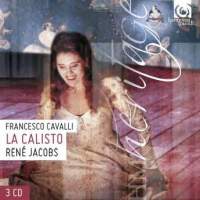Texte paru dans: / Appeared in: |
|
|
Outil de traduction |
|
|
|
|
|
Reviewer: David
Johnson Abridged version:
The recording confirms my impression, as I left the theater, that I had heard a first-rate performance of a masterwork. Though I still have some reservations—for instance, with the casting of Maria Bayo as Eternity in the prolog, where she is called upon to raise Calisto (the role she assumes in the body of the opera) to the stars, and with the choice of a tenor Linfea when the only surviving manuscript score specifies a soprano—but on the whole René Jacobs's musicological decisions and his choice of cast and instrumental accompaniment strike me as just about right. As Jove, Marcello Lippi has a firm, handsome baritone voice, which he transforms into a surprisingly convincing countertenor when disguising himself as the goddess Diana in order to seduce Calisto. I hope Lippi was not doing damage to his vocal cords in the process. In the manuscript the part of Jove is written in the bass clef, that of Jove-as-Diana in the soprano clef, leading some authorities to speculate that the soprano who sang Diana also sang Jove disguised as Diana. That was the solution preferred by Leppard. Jacobs prefers to have Lippi disguise his voice by using voce finta (falsetto) and avoiding the highest notes. The role of Endymion is sung by a “real“ voce finta, the countertenor Graham Pushee, who could easily pass as a female alto without vibrato—an excellent representative of the species. And to compound the sexual ambiguity in this most sexually sere wed-up of operas, the part of the nymph Linfea is, as I remarked before, sung here by a tenor. In reviewing the Stradivarius Calisto I objected to this practice. Linfea, true enough, is a comic character—a virginal nymphomaniac—but she is not “an old nymph“ as Harmonia Mundi's plot summarizer insists on describing her. She is not even unattractive: the little Satyr tries unsuccessfully to seduce her. Most important of all, the part is written in the soprano, not the tenor, clef. Nonetheless, this recording as well as Leppard's cast a tenor as Linfea. Hugues Cuénod, on the Leppard, was admittedly a very funny nymph; Gilles Ragon is less so. The Stradivarius version correctly opts for a soprano, but she has no sense of humor. Someday, perhaps, the perfect Linfea will be found, with the voice of Dawn Upshaw and the personality of Anna Russell. The little Satyr is portrayed deliciously by a truly comic singer, the countertenor Dominque Visse, who was as amusing on stage as he is on discs. His list of his own physical attractions, as he woos Linfea, include soft hairs that cover his body, tender as down, and cheeks undefiled by whiskers but spotted “with blooming roses“ (which one takes to mean adolescent eczema). That brings up the subject of translating Giovani Faustini's much-praised libretto. The task is not an easy one, for the poetry is highly allusive, filled with archaic words and inverted syntax. The Stradivarius recording avoids the problem altogether by providing no translation at all. Harmonia Mundi provides three of them, French, English, and German, in parallel columns with the Italian. * We are even given footnotes to explain the many mythological allusions. This in itself recommends Harmonia Mundi's La Calisto over its rival, and role for role HM's cast completes the conquest with more experienced singers and more attractive voices. I have already commended Bayo, Lippi, Pushee, and Visse. Alessandra Mantovani is the Diana (a role she also sings on the Stradivarius recording). Compared with Janet Baker, Mantovani is a mere neophyte, but without the invidious comparison she does quite well. Simon Keenlyside is a baritone Mercury, in contrast to the tenor on Stradivarius, but his truly mercurial voice can sound tenorlike when he wants it to and he makes a daunting, Leoporello-like cynic as Jove's factotum. Although René Jacobs makes what amounts to an apologia for increasing the size of his instrumental group over what Cavalli would have called for at the 200-seat Teatro San Apollinare in Venice, where La Calisto first saw the light in 1651, some listeners may wish that Jacobs had been ever more generous in the number of strings he employs: only two violins, two violas, with cello and double bass in the continuo. But he does bring in, on occasion, two recorders, a dulcian, and two cornets, as well as a varied array of continuo players, including no fewer than four harpsichords, two organ positifs, two lutes, archlute, guitar, harp, lirone, viola da gamba, and percussion. These extended members of Jacobs's Concerto Vocale make as big a noise, or as small, as required. Jacobs also calls upon an array of instrumental interludes required by the drama but not supplied in the manuscript source. He borrows these from some of Cavalli's contemporaries: Cazzati, Cesti, Krieger, Marini, Menila, Uccellini, and Schmelzer. These composers should have been identified in the libretto as their music is played. We are told only that the bear dances to a chaconne by Tarquinio Merula and that Heinrich Schmelzer wrote the chaconne that concludes the opera. But these are small details and do not affect my hearty recommendation of this album.
| |
|
|
|
|
|
|
|
Cliquez l'un ou l'autre
bouton pour découvrir bien d'autres critiques de CD |
|




